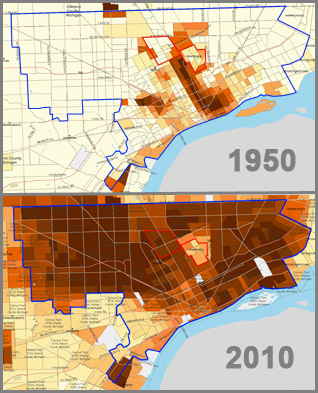Squandered opportunities leave Detroit isolated
It also recommended the creation of several new authorities to plan for and coordinate in regards to economic development, health care delivery, transportation, and housing, all to be housed under the new regional agency.
“It was very ambitious,” Mogk said. “We wanted to give an honest assessment of what the problems were and what it would take to solve them.”
The Task Force made its recommendations while Roman Gribbs was the Mayor of Detroit. According to Mogk, Gribbs was very interested in the report’s findings. In 1974, however, Coleman Young was elected, and he showed far less enthusiasm. “Young never displayed any interest in this at all,” Mogk said. Without support from either the city or the suburbs, none of the report’s recommendations were put into place.
While local apathy was mirrored, for the most part, in the State Capitol, there were a handful of state officials who displayed an interest in regionalism at the time, including Governor William Milliken and Speaker of the State House of Representatives William Ryan. In late 1975, Ryan introduced a bill to the legislature called the Local Cooperation Act, which also would have created a new regional planning agency to replace SEMCOG. As with the TOP report, the bill went nowhere.
“There’s never been any kind of long-term plan”
Under both proposals, a new regional entity would have been charged with creating a long-term master plan for the region. Especially in terms of land use and economic development, Mogk said, this could have had substantial benefits.
“Most of the new factories that were built in the area after World War II were built in the suburbs,” Mogk said. Advancements in technology required factories to be single-story, which made many of the multi-story factories in Detroit obsolete. In the suburbs, there was a significant amount of cleared land available to be bought cheaply. According to Mogk, there was still a sizable amount of available land in Detroit, as well, but building on it would have required rezoning and, in some cases, moving residents from one part of the city to another. That relocation would likely have required the construction of new, affordable housing.
A profound demographic change
Map & Data Resources
See how demographics in Detroit have changed over the last 60 years.
Had an entity existed with the resources and authority to create a regional master plan for land use, Mogk said, it may have been possible to arrest the process of deindustrialization in the city. “If you had an economic and land use plan, you could have said that a certain number of acres would be dedicated to industrial use, a certain number for affordable housing, a certain number for commercial use, and you could have made decisions about where in the region those investments should be made.”
Joe Darden, an assistant professor of geography at Michigan State University and a co-author of Detroit, Race, and Uneven Development, agreed. According to Darden, it would have been especially beneficial if housing and transportation policy had been made on a regional basis, as the Task Force had recommended. Placing more affordable housing in suburban communities would have made the region less segregated and potentially reduced the white flight from the city, he said, and coordinating transportation regionally would have allowed for more mobility for city residents to jobs in the suburbs, and vice versa.
Darden also pointed out that the lack of coordination in the region has led to significant duplication of services. “Everybody wants to have their own fire department, their own school system, their own sanitation department,” he said. “That’s a tremendous waste of resources that could be used for productive purposes.”
Both Mogk and Darden said that the region would look very different today if the Task Force recommendations had been put into place or the Local Cooperation Act passed. “There would probably be much more balance in terms of investment between Detroit and the suburbs,” Darden said. “The movement out of the city would not have been as great, and Detroit would have gained from an economic standpoint.”
Milliken v. Bradley
The Detroit region has long been one of the most segregated metropolitan areas in the country. By 1970, African Americans had already become largely concentrated in the city, while the suburbs were almost exclusively white.
Because African Americans were locked out of many of the new, well-paying jobs in the suburbs, and because the city was not producing many jobs of its own, Detroit became steadily more impoverished throughout the 1960s and 1970s. “When you have vastly unequal places in a region, investment goes to the richer one,” Darden said. “So some of Detroit’s suburbs are some of the wealthiest towns in the country, and in Detroit you have an astounding level of concentrated poverty.”

